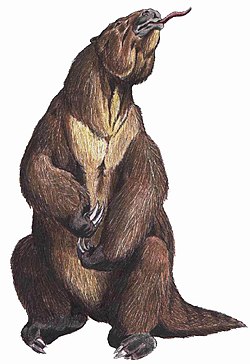| Ocnotherium Temporal range: | |
|---|---|
| Scientific classification | |
| Kingdom: | Animalia |
| Phylum: | Chordata |
| Class: | Mammalia |
| Order: | Pilosa |
| Family: | † Mylodontidae |
| Subfamily: | † Mylodontinae |
| Genus: | † Ocnotherium Lund, 1842 |
| Type species | |
| Ocnotherium giganteum (Lund, 1839) | |
Ocnotherium is an extinct genus of ground sloth known from the Late Pleistocene of Brazil, belonging to the family Mylodontidae, containing the species Ocnotherium giganteum. It is a member of the subfamily Mylodontinae, but its relationship to other members of that subfamily are uncertain. [1] It had osteoderms embedded within its skin, like some other mylodontids. [2] It was likely a mixed feeder, [3] and may have been adapted to digging. [4]

